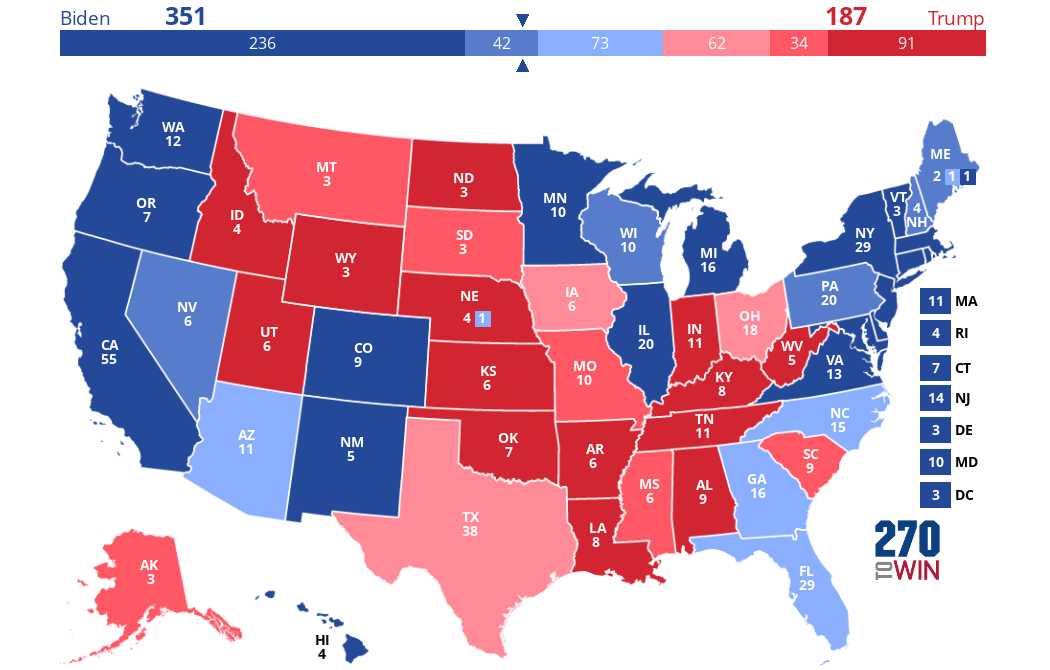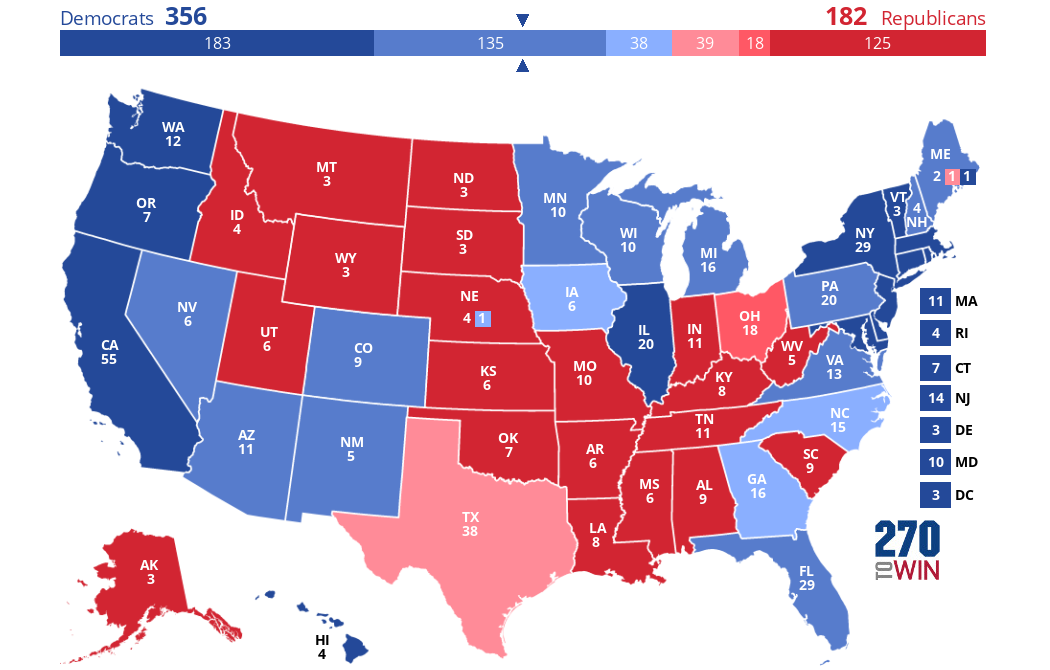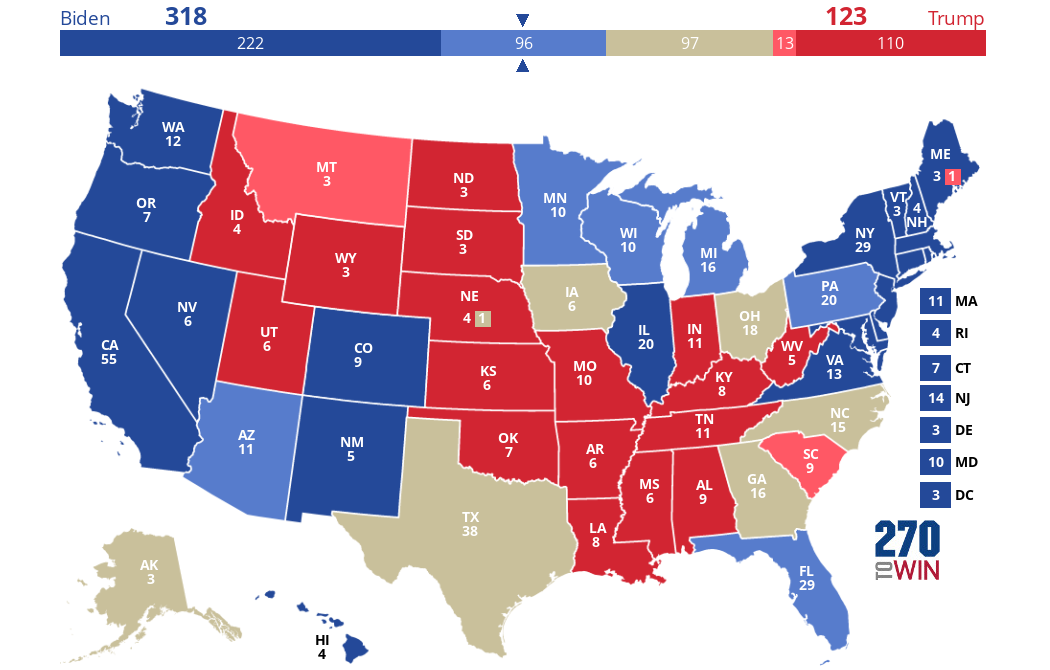The most notable outcome of the 2020 U.S. election was that, as expected, Trump lost both the popular vote and the electoral college. However, the polls experienced significant errors, the nature of which is still being debated. Overall, it appears that polling understated support for Trump and the Republicans by about three or four points. It is also clear that there was a Republican anti-Trump vote (a group of Republican voters who were small 'c' conservatives that opposed Trump, but also supported Republican candidates for the U.S. House of Representatives). There was also increased turnout from a pro-Trump constituency, many likely middle aged or older and voting for the first time. The results disappointed Democrats who expected more. However, the party seems to trail the Republicans when it comes to innovative campaign techniques and it made other mistakes in its congressional campaigning.
Polling Error
There appears to have been a general problem with the polling. As the highly respected Pew Research Center noted:
...the election was much closer than polls suggested in several battleground states (e.g., Wisconsin) and more decisive for Trump elsewhere (e.g., Ohio). ... it’s clear that national and many state estimates were not just off, but off in the same direction: They favored the Democratic candidate...Looking across the 12 battleground states from the upper Midwest (where many polls missed the mark) to the Sun Belt and Southwest (where many were stronger), polls overestimated the Democratic advantage by an average of about 4 percentage points. When looking at national polls, the Democratic overstatement will end up being similar, about 4 points...The fact that the polling errors were not random, and that they almost uniformly involved underestimates of Republican rather than Democratic performance, points to a systematic cause or set of causes.
Although Nate Silver of the blog FiveThirtyEight called the miss "pretty normal by historical standards", he links those words to a blog post from Vox whose sub-headline is "The kind of people who answer polls are really weird, and it’s ruining polling" - hardly illustrative of the point he was trying to make. The author of that post quotes a Democratic polling expert named David Shor who says of 2020, "the kind of people who answer polls are systematically different from the kind of people who refuse to answer polls — and that this has recently begun biasing the polls in a systematic way."
My view is that there was a systematic problem. It likely had more than one cause. One possibility might be that the pandemic had a unique impact. Pew says:
The once-in-a-generation coronavirus pandemic dramatically altered how people intended to vote, with Democrats disproportionately concerned about the virus and using early voting (either by mail or in person) and Republicans more likely to vote in person on Election Day itself. In such an unusual year – with so many people voting early for the first time and some states changing their procedures – it’s possible that some Democrats who thought they had, or would, cast a ballot did not successfully do so. A related point is that Trump and the Republican Party conducted a more traditional get-out-the-vote effort in the campaign’s final weeks, with large rallies and door-to-door canvassing. These may have further confounded likely voter models.
While this argument does have merit Pew also suggests another explanation that makes sense to me:
The overall share of Republicans in survey samples was roughly correct, but the samples underrepresented the most hard-core Trump supporters in the party. One possible corollary of this theory is that Republicans’ widespread lack of trust in institutions like the news media – which sponsors a great deal of polling – led some people to not want to participate in polls.
The pronounced alienation of some parts of the population from institutions may be a broader phenomenon than we have appreciated. I had noted to myself that in Canada the Conservatives were sometimes underestimated in Canadian polls, especially in Alberta. I double checked for this post, and confirmed that an average of the closing polls in Alberta in the 2019 federal election underestimated the party's actual vote share in the election by about ten points, well outside any margin of error. There have also been other collective poll misses, particularly in the BC election in 2013, where again it was the political right that was under-estimated. The Alberta miss was in the most small 'c' conservative province in Canada, one with a history of rural right of centre populism. It is possible that normal polling is undercounting rural conservatives.
Rural Resentment
American political scientist Kathy Cramer investigated rural resentment in Wisconsin before the Trump era, producing a book aimed at explaining support for a conservative Trump-like Republican Governor named Scott Walker. She did so by travelling all over the state joining coffee klatches, talking and listening to the participants, a different way of measuring public opinion. Her analysis is important to understanding attitudes to Trump and indirectly what happened in this year's election. Here is an edited version of what she found, as summarized by an observer to a lecture she gave:
Rural consciousness is identifying as a rural person... and a strong perception of distributive injustice that disfavors you and your identity. Cramer notes that this ... comprises resentment toward: cities and city people, elites (government, financial, cultural), people of color, and partisan polarization. "(This) ...makes rural consciousness a fertile ground for populism. Cramer defines populism here as essentially, “people are good and government is bad.”
Rural folks explain, “Our hard-earned taxpayer dollars are going to people who do not deserve them.” They thoroughly believe that others don’t work as hard as they do. And by hard work they mean, “when you have to shower after work, not before it.” And when Cramer followed up with the groups after the book came out, they agreed that they were resentful.
There is also a sense of loss. That these people’s communities and their standard of living have been taken away—that their status is threatened.
... (T)here is a belief that government is urban and distant. Even if workers are local, the decisions they follow are from the city to the rural area. They believe the government is not really working for them....
Cramer is still reflecting on how Donald Trump’s campaign activated rural consciousness. In contrast to Scott Walker’s assault on public employees, Donald Trump pointed to immigrants, Muslims, and women as undeserving groups. ...
Importantly, when she asks these rural folks what they hope will change with the new administration, they say they don’t expect anything to change. They set a very low bar. And it’s clear to her, that their criteria for Trump’s success is not anything like liberals criteria. They don’t believe he is going to solve their problems....
This latter point is important. It explains why, despite Trump's manifest incompetence and failure to improve the lives of his supporters, what ends up mattering to them are the symbolic steps he takes, as they don't actually believe he can accomplish anything meaningful for them.
Turnout
Democrats voted by mail in large numbers because of fear of the pandemic, but precisely because they feared the pandemic, I suspect it is likely a significant number of Democratic voters did not show up in person to vote on election day. Given that turnout was up significantly it is extremely difficult to calculate the exact dimensions of this, although we may see efforts to do so in the months ahead. I want to emphasize that there could both be a large increase in turnout overall of Democratic votes because of intense anti-Trump feelings, while simultaneously there could have been a lower than anticipated turnout of in person Democratic votes on election day, because of pandemic fears. Republicans did not share fear of the virus nearly as much as Democrats, because of the absurd, but widely believed propaganda, peddled by the right. For example, watch this CNN interview with a nurse from a small town in South Dakota who treated patients who clearly thought the virus was a hoax, and desperately wanted to believe their COVID-19 was some other illness.
"I started talking about ... their micro-target efforts and like what they were doing with Latino voters way way way back in 2018 about how the um you know Republicans. It was going to be heavily reliant on digital targeting through Youtube, Facebook, targeting voters of color, young men Latino and black young men with these micro-targeted ads. It relies on the assumption that these people don't know anything about politics, they know nothing, they're a clean slate, and so therefore it doesn't matter in if in reality Donald Trump is a racist, the GOP platform is the most racially hostile it's been ever, these things don't matter if you have a voter that knows nothing and you come in and you start talking to them about the 1994 crime bill [Biden supported it and it has been deemed to have targeted blacks] and you make that the salient issue. You'll suddenly start hearing talking points coming out of the communities of color and that is that Democrats take black voters for granted.... You could hear this on MSNBC, they were interviewing some black voters in Atlanta, what is the main thing they are considering... 'I still haven't come in all the way in for Biden because I'm really upset about that crime bill'... She is thinking about the crime bill... They're not thinking about Donald Trump's contemporaneous record on race."
On the same panel. Rick Wilson of the Lincoln Project commented (around 1;02:30): "We had guys trawling through the thousands and thousands of ad variants they ran on Facebook to pick out these different things and you could have seen people living next door to each other, and in one house they were getting the message that scary brown people are coming to kill you, and the house next door would be Joe Biden puts brown people in jail and that that, that, that ability of Facebook to profoundly manipulate voter behavior is the most unappreciated aspect of the last 10 years of our campaigns."




 Click the map to create your own at
Click the map to create your own at 






















